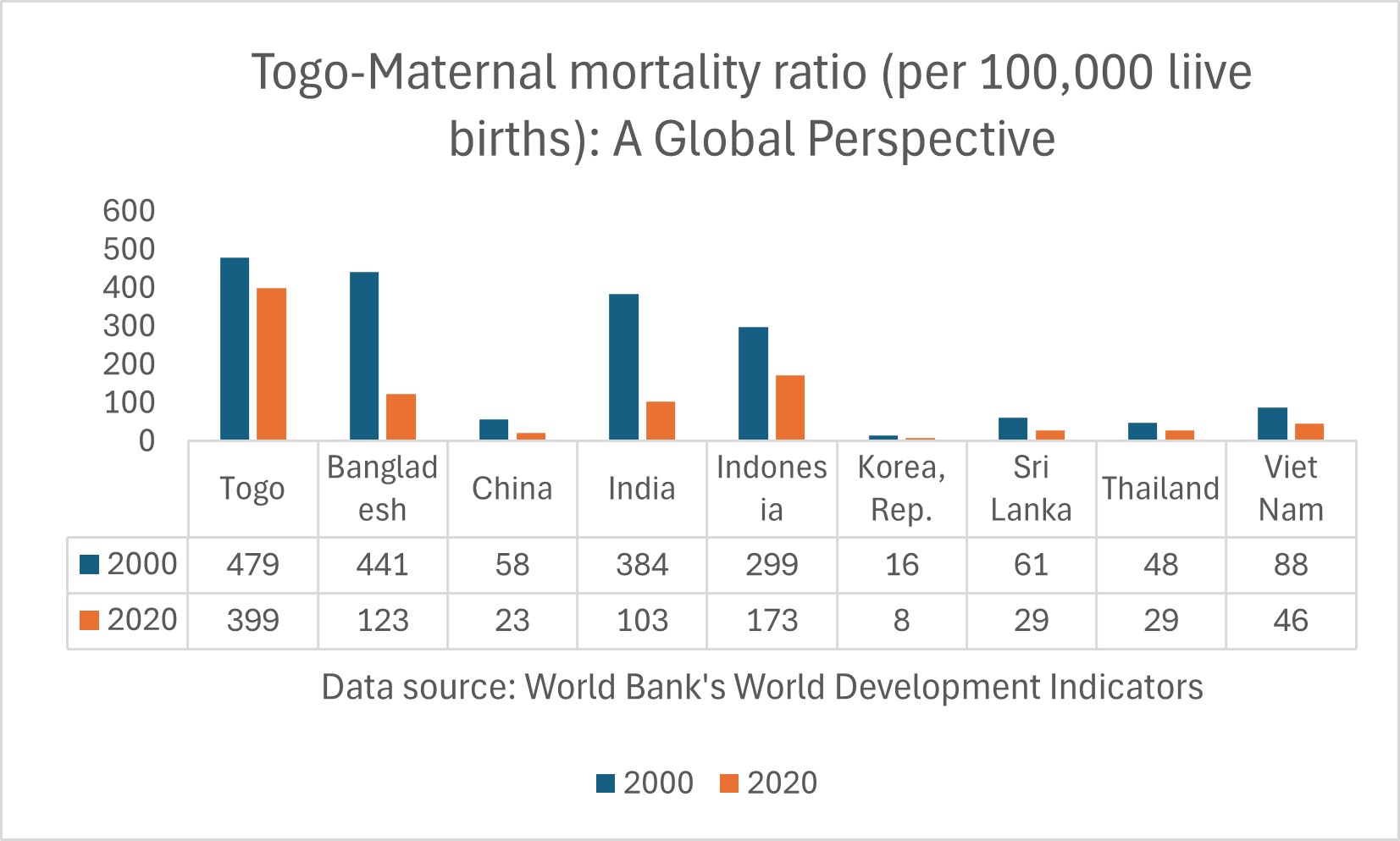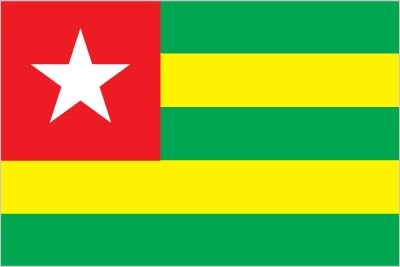
Togo
Country Flag Details
five equal horizontal bands of green (top and bottom) alternating with yellow; a white five-pointed star on a red square is in the upper hoist-side corner; the five horizontal stripes stand for the five different regions of the country; the red square is meant to express the loyalty and patriotism of the people, green symbolizes hope, fertility, and agriculture, while yellow represents mineral wealth and faith that hard work and strength will bring prosperity; the star symbolizes life, purity, peace, dignity, and Togo’s independence
note: uses the popular Pan-African colors of Ethiopia
Background
From the 11th to the 16th centuries, various ethnic groups settled the Togo region. After World War I, colonial rule over Togo was transferred from Germany to France. French Togoland became Togo upon independence in 1960.
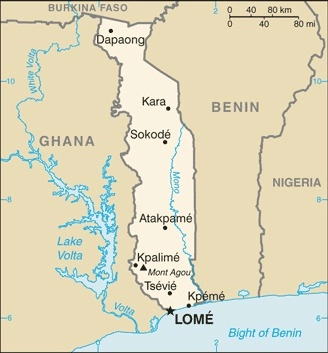
Geography
Area
total : 56,785 sq km
land: 54,385 sq km
water: 2,400 sq km
Climate
tropical; hot, humid in south; semiarid in north
Natural resources
phosphates, limestone, marble, arable land
People and Society
Population
total: 8,917,994
Ethnic groups
Adja-Ewe/Mina 42.4%, Kabye/Tem 25.9%, Para-Gourma/Akan 17.1%, Akposso/Akebu 4.1%, Ana-Ife 3.2%, other Togolese 1.7%, foreigners 5.2%, no response 0.4% (2013-14 est.)
Languages
French (official, language of commerce), Ewe and Mina (in the south), Kabye (sometimes spelled Kabiye) and Dagomba (in the north)
Religions
Christian 42.3%, folk religion 36.9%, Muslim 14%, Hindu <1%, Buddhist <1%, Jewish <1%, other <1%, none 6.2% (2020 est.)
Population growth rate
2.41% (2024 est.)
Government
Government type
presidential republic
Capital name: Lome
Executive branch
chief of state: President Faure GNASSINGBE (since 4 May 2005)
head of government: Prime Minister Victoire TOMEGAH Dogbé (since 25 September 2020)
Economy
Real GDP (purchasing power parity)
$25.75 billion (2023 est.)
$24.199 billion (2022 est.)
$22.881 billion (2021 est.)
Real GDP per capita
$2,800 (2023 est.)
$2,700 (2022 est.)
$2,600 (2021 est.)
Exports
$1.722 billion (2020 est.)
$1.665 billion (2019 est.)
$1.703 billion (2018 est.)
Exports – partners
UAE 40%, India 13%, Angola 13%, Burkina Faso 4%, Cote d’Ivoire 3% (2023)
Exports – commodities
gold, refined petroleum, soybeans, phosphates, coconuts/brazil nuts/cashews (2023)
Imports
$2.389 billion (2020 est.)
$2.261 billion (2019 est.)
$2.329 billion (2018 est.)
Imports – partners
China 26%, India 26%, Belgium 6%, Netherlands 6%, USA 3% (2023)
Imports – commodities
refined petroleum, garments, rice, palm oil, motorcycles and cycles (2023)

Export structure by product groups in 2023 (% of total export) (UNCTAD)
The export structure of a country serves as a comprehensive reflection of the diversity, composition, and economic significance of the goods and services it trades on an international scale, making it a crucial metric for assessing the nation’s economic health, global competitiveness, and level of development. In the case of Togo, its export structure is notably diverse, incorporating a range of minerals, agricultural products, and manufactured goods, which collectively illustrate the nation’s potential across various sectors. Despite these advantages, it is imperative to confront the ongoing trade imbalance and actively pursue the diversification of export markets to foster enduring and sustainable economic growth for the country.
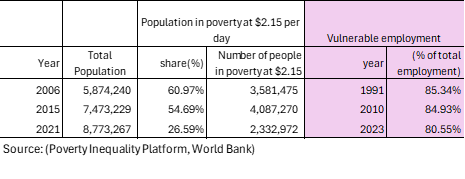
Poverty and vulnerable employment in Togo (World Bank)
In 2023, 81 percent of Togo’ s total employment was classified as vulnerable employment. Vulnerable employment is a type of work marked by insufficient job security, low wages, and a lack of essential social protections such as health insurance, pensions, and labor rights. This category primarily encompasses own-account workers, who are self-employed without any employees such as street vendors and small-scale farmers, as well as contributing family workers, who assist in family-run businesses or farms without receiving formal wages. In Togo, as of 2023, a staggering 80.55 percent of the total labor force is involved in vulnerable employment. Jobs in this sector are often informal and unstable, devoid of benefits, which renders workers particularly vulnerable to economic shocks, exploitation, and poverty.
Understanding poverty level significance at $2.15 per day
In 2021, 27 percent of Togo’s population lived in poverty at$2.15 per day.The poverty level at $2.15 per day (measured in 2017 purchasing power parity, or PPP) is a key global benchmark used by the World Bank to define extreme poverty in low-income countries. It indicates:
1. Basic Survival Threshold
• People living below $2.15 per day struggle to afford essential needs such as food, clean water, shelter, healthcare, and education.
2. Economic Underdevelopment
• A high percentage of a country’s population living below this threshold suggests low economic productivity, high unemployment, and weak social safety nets.
3. Inequality and Social Vulnerability
• It reflects deep income inequality and a lack of access to opportunities for upward mobility.
• People in this category are more vulnerable to shocks like food price increases, climate disasters, or health crises.
4. Policy Challenges
• Governments need targeted interventions such as social welfare programs, job creation, and improved access to education and healthcare to reduce poverty.
A country's export structure is a reflection of its level of development and productive capacities
The export structure of a country refers to the composition, diversity, and value of the goods and services it sells to other countries. It provides key insights into the country’s economic health, competitiveness, and level of development. Productive capacities of a country refer to its ability to produce goods and services efficiently and sustainably over time. These capacities are shaped by various factors, including human capital, natural resources, infrastructure, private sector, development, technology & innovation, institutions & governance, financial systems trade & market access.
Here’s what the export structure and productive capacities of a country typically indicate:
- Level of Economic Development
- Developed economies usually export high-value manufactured goods, technology, and services.
- Developing economies often rely on raw materials, agricultural products, or low-value manufactured goods.
- Industrial and Sectoral Strengths
- A strong presence of high-tech or industrial goods (e.g., machinery, electronics) suggests a well-developed manufacturing sector.
- A dominance of commodities (e.g., oil, minerals, agricultural products) indicates reliance on natural resources.
- Export Diversification
- A diverse export base (multiple industries) makes a country’s economy more stable and resilient to global price shocks.
- A concentrated export base (few key products) makes it vulnerable to market fluctuations.
- Trade Partnerships and Dependence
- If exports are heavily dependent on a single country or region, the economy is more exposed to geopolitical and trade risks.
- A wide range of trading partners indicates stronger global integration.
- Competitiveness and Value Addition
- Exporting mainly raw materials (e.g., crude oil instead of refined petroleum) suggests limited industrial processing capacity.
- A high share of finished and high-tech goods suggests strong value addition and competitiveness.
Togo-Sanitation
Togo- Proportion of population served with at least basic sanitation
In 2022, proportion of population served with at least basic sanitation for Togo was 19.2 %. Proportion of population served with at least basic sanitation of Togo increased from 9.6 % in 2000 to 19.2 % in 2022 an absolute change of 9.6 percentage points (pp) between 2000 and 2022.
Togo – Proportion of urban population served with at least basic sanitation
In 2022, proportion of urban population served with at least basic sanitation for Togo was 32.1 %. Proportion of urban population served with at least basic sanitation of Togo increased from 23.6 % in 2000 to 32.1 % in 2022 an absolute change of 8.5pp between 2000 and 2022.
Togo – Proportion of rural population served with at least basic sanitation
In 2022, proportion of rural population served with at least basic sanitation for Togo was 9.1 %. Proportion of rural population served with at least basic sanitation of Togo increased from 2.7 % in 2000 to 9.1 % in 2022 an absolute change of 6.4 pp between 2000 and 2022.
Togo- Proportion of total population served with at least basic sanitation: A Global Perspective
The ongoing challenge of inadequate sanitation poses a dire threat that calls for urgent and unified action, leading to the preventable deaths of hundreds of thousands of people each year and emphasizing a major public health crisis that cannot be ignored. Access to safe sanitation is not simply a requirement; it is a fundamental human right that everyone is entitled to without exception. In the year 2022, around 7 million individuals, or nearly 81 percent of Togo’s population, faced the harsh realities of insufficient sanitation facilities, starkly contrasting with countries like Vietnam, China, and Thailand, which reported significantly lower percentages, with only 8 percent, 5 percent, and 1 percent of their populations lacking this crucial service. Meanwhile, the global average for those without sanitation access stands at approximately 6 percent, further highlighting the pressing need for collective efforts to improve sanitation in the underserved regions of Sub-Saharan Africa where the situation remains critical and urgent.

Togo- Proportion of rural population not served with at least basic sanitation: A Global Perspective
In 2022 nearly 4.6 million individuals in the rural areas of Togo which accounts for approximately 91% of this population were deprived of access to basic sanitation facilities revealing a stark disparity when compared to countries such as Vietnam Sri Lanka and Thailand where only 12% 5% and 2% of their populations lack similar access. This widespread absence of safe sanitation is not just an urgent issue; it is a critical crisis that demands our immediate collective action as it is directly responsible for the preventable deaths of countless individuals each year highlighting a significant public health emergency that requires our intervention. Access to safe sanitation is more than a basic necessity; it is an inherent human right that every person should have the opportunity to realize without exception. Therefore it is imperative that we unite our efforts to promote and advocate for this indispensable right throughout Sub-Saharan Africa where the urgency for improvement is the highest and the potential for meaningful change within communities is immense.
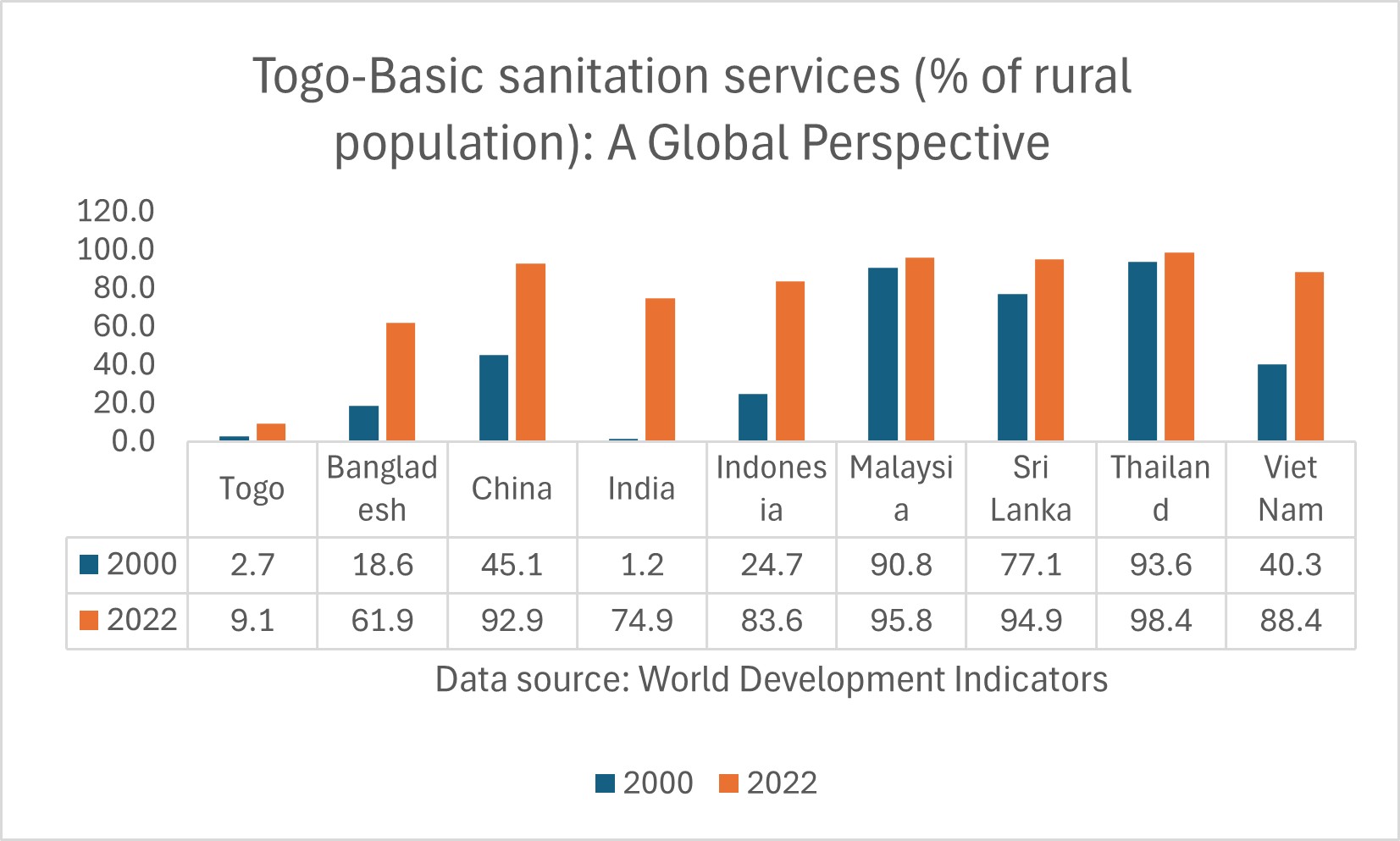
Togo-Water Supply
Togo – Proportion of total population served with at least basic water
In 2022, proportion of population served with at least basic water for Togo was 71 %. Proportion of population served with at least basic water of Togo increased from 45.4 % in 2000 to 71 % in 2022 an absolute change of 25.6 pp between 2000 and 2022.
Togo- Proportion of urban population served with at least basic water
In 2022, proportion of urban population served with at least basic water for Togo was 87 %. Proportion of urban population served with at least basic water of Togo increased from 82.1 % in 2000 to 87 % in 2022 an absolute change of 4.9pp between 2000 and 2022.
Togo- Proportion of rural population with at least basic water
In 2022, proportion of rural population served with at least basic water for Togo was 58.0 %. Proportion of rural population served with at least basic water of Togo increased from 27.5 % in 2000 to 58.5 % in 2022 an absolute change of 31 pp between 2000 and 2022.
Togo – Proportion of total population not served with at least basic water: A Global Perspective
Access to safe drinking water is not merely a fundamental human need; it is an essential human right that is crucial for fostering health and well-being in communities worldwide. It is deeply alarming to recognize that in 2022, approximately 2.6 million individuals in Togo, accounting for around 29 percent of the population, were denied this critical resource, revealing a profound inequality in access to basic necessities that numerous people take for granted in their daily lives. In stark contrast, every individual in Thailand had access to safe drinking water, and a remarkable 98 percent of the populations in both Bangladesh and Vietnam enjoyed this vital right without hindrance. These glaring disparities underscore the urgent need for coordinated and compassionate efforts to enhance living conditions and ensure equitable access to safe drinking water for at-risk communities throughout Sub-Saharan Africa, where the consequences of such inequities place immense strain on health systems and demand our immediate focus and action to rectify this situation.
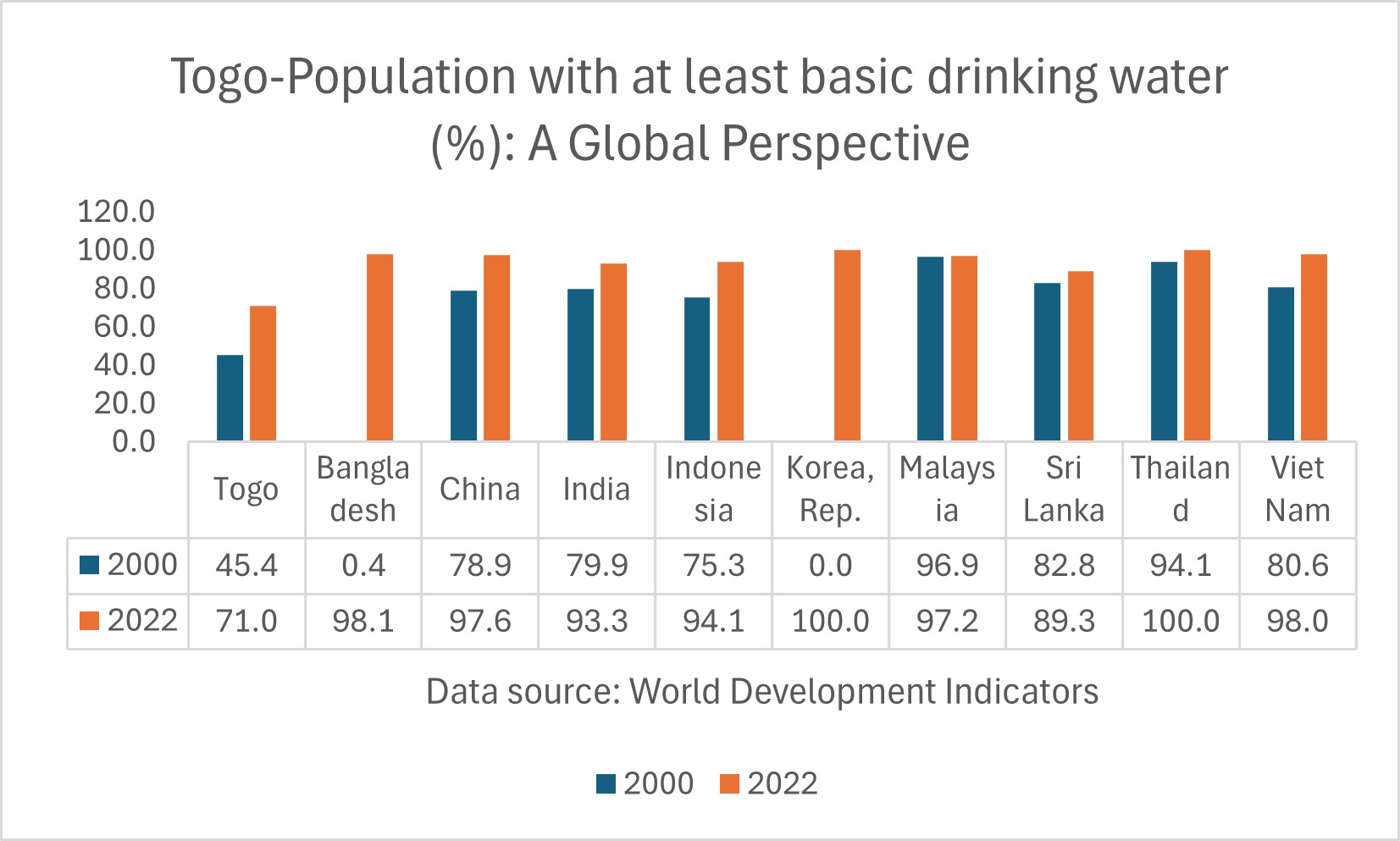
Togo – Proportion of rural population not served with at least basic water: A Global Perspective
In 2022, a distressing 41 percent of the rural population in Togo lacked access to drinking water facilities, translating to roughly 2 million individuals within these communities being deprived of safe drinking water sources that are essential for health and well-being. This sobering reality stands in stark contrast to nations such as Thailand and Bangladesh, where a remarkable 100 percent and 98 percent of their rural populations, respectively, enjoyed access to safe drinking water during the same year. This significant disparity not only highlights the dire situation faced by millions in Togo, but also underscores the urgent necessity for transformative action across Sub-Saharan African countries. It reinforces the critical need to confront and address the fundamental issues surrounding water accessibility and sustainability in this region. The ongoing challenge of inadequate water access remains a pressing concern, demanding immediate attention to improve health outcomes and foster sustainable development initiatives that can uplift communities and promote resilience in this region.
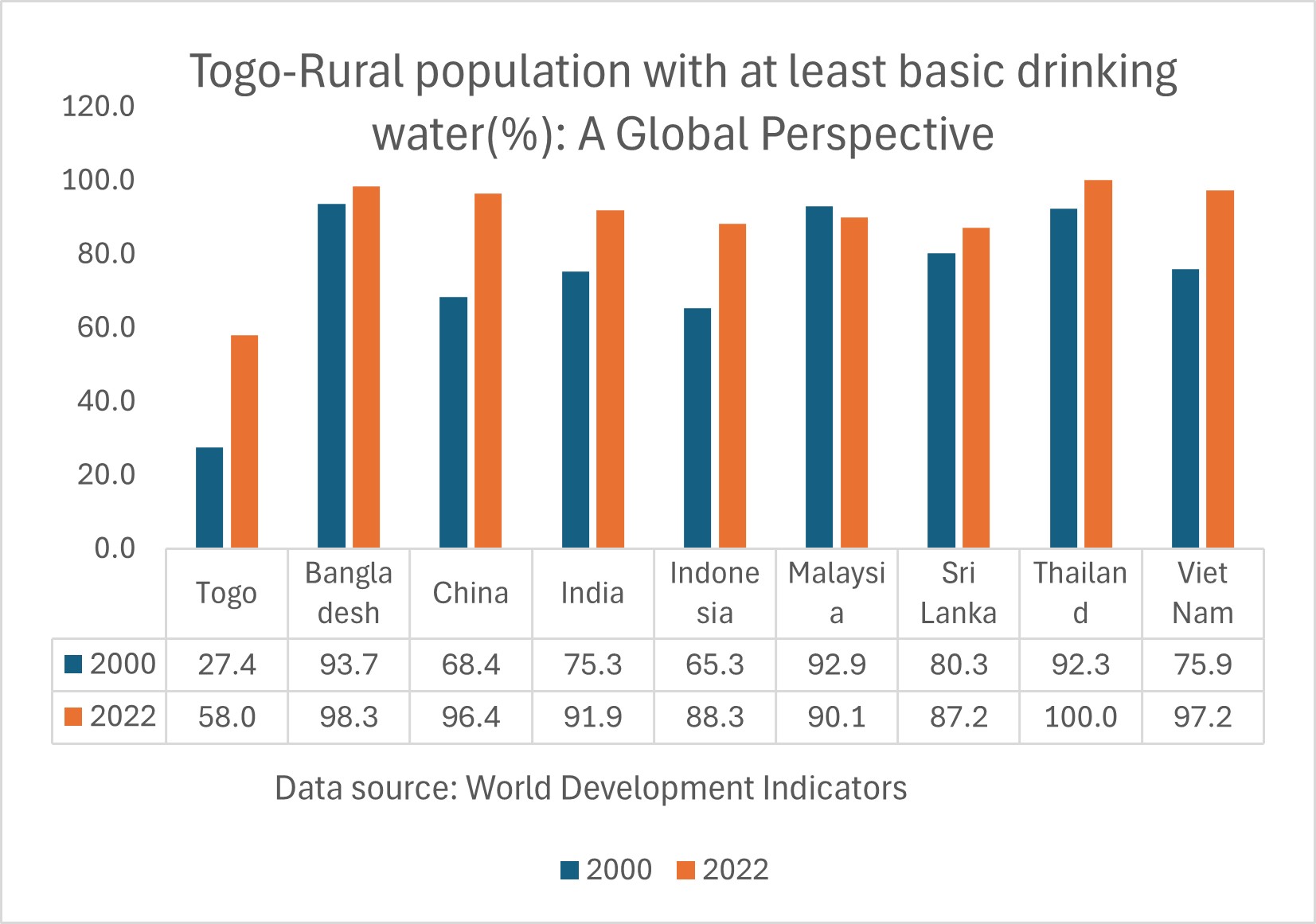
Togo-Access to Electricity
Togo-Access to electricity (% of population): A Global Perspective
In 2022, proportion of population with access to electricity for Togo was 57.2 %. The proportion of population with access to electricity of Togo increased from 17% in 2000 to 57.2% in 2022, an absolute change of 40.2pp between 2000 and 2025.
Togo-Access to electricity (% urban population)
In 2022, proportion of urban population with access to electricity for Togo was 96.5%. The proportion of urban population with access to electricity of Togo increased from 38.5% % in 2000 to 96.5% in 2022, an absolute change of 58.0pp between 2000 and 2022.
Togo-Access to electricity (% rural population)
In 2022, proportion of rural population with access to electricity for Togo was 25 % in 2022. The proportion of rural population with access to electricity of Togo increased from 6.4 % % in 2000 to 25% in 2022, an absolute change of 18.5pp between 2000 and 2022.
Togo – Proportion of total population not served with electricity: A Global Perspective
In 2022 nearly 43 percent of Togo’s population was devoid of access to electricity a stark indicator of inequality as over 3 million residents lack this vital service essential for daily living and economic activities in which households struggle to meet basic needs and businesses face debilitating constraints This situation becomes even more alarming when viewed in contrast to countries such as Vietnam Thailand Sri Lanka and Malaysia where the achievement of 100 percent electricity access reflects a strong commitment to infrastructure development and social equity These disparities highlight a pressing need for comprehensive reforms across Sub-Saharan Africa aimed at not only enhancing the quality of life for its citizens but also fostering an environment where reliable and sustainable energy sources are accessible to all Access to electricity transcends mere convenience it is a fundamental necessity that can catalyze transformative progress across multiple sectors including health education and economic growth thereby significantly elevating living standards and creating a wealth of opportunities for a more promising and prosperous future for all.
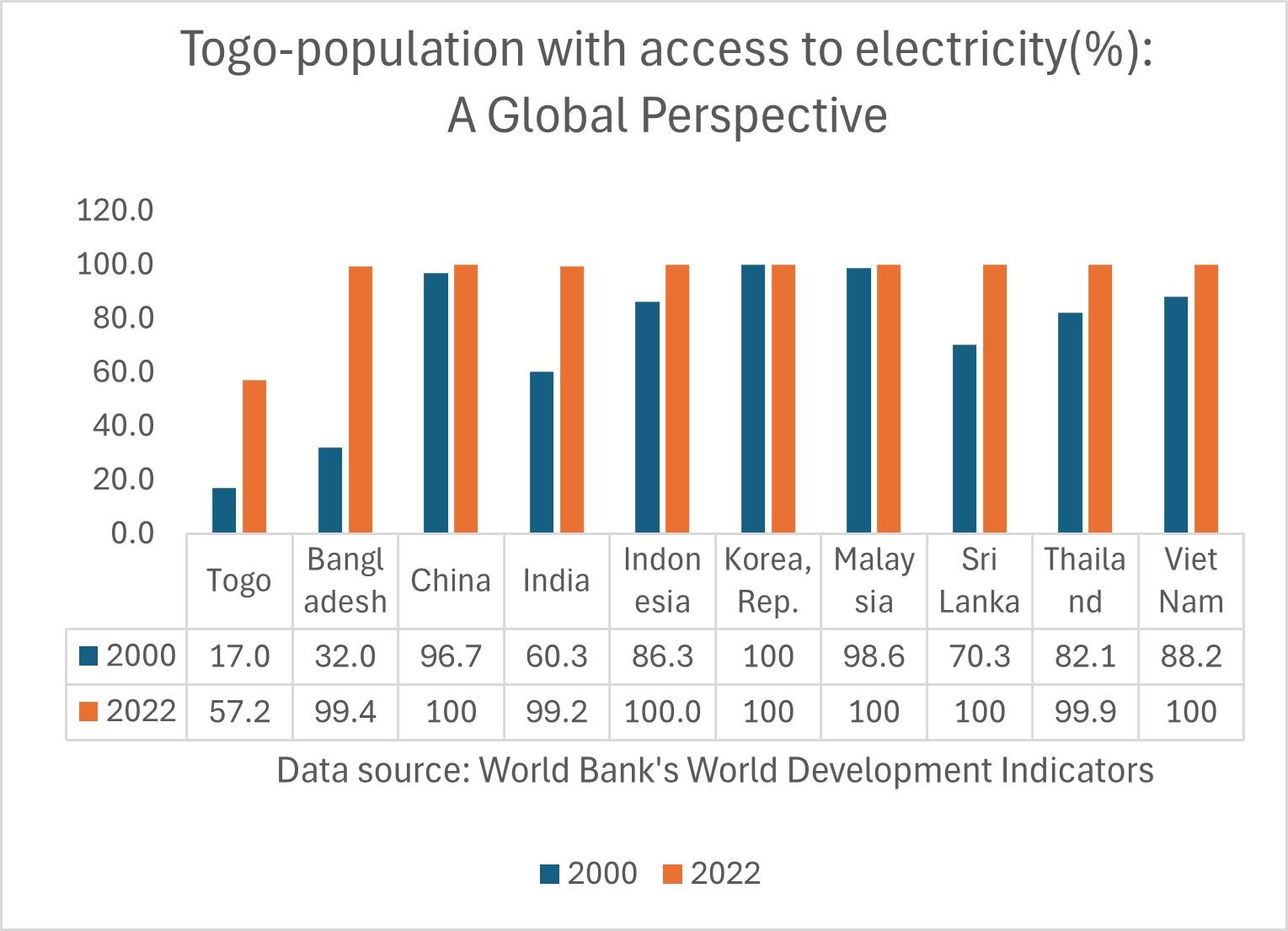
Togo – Proportion of rural population not served with electricity: A Global Perspective
In 2022, a staggering 3.7 million people, representing approximately 75 percent of the rural population in Togo, faced the harsh reality of living without electricity, a situation that strikingly underscores the glaring disparities when compared to nations such as Vietnam, Thailand, and Sri Lanka, where every individual in rural areas enjoys full access to this essential resource that underpins daily life and fosters development. Even in countries like India and Bangladesh, an impressive 99 percent of the rural populace benefits from reliable electricity, which significantly enhances their quality of life and opens up avenues for growth and opportunity. These alarming figures are more than mere statistics; they reveal an urgent and critical need for profound and heartfelt governance reforms throughout Sub-Saharan Africa. It is imperative that every community receives dependable access to electricity, as this fundamental resource lays the groundwork for them to flourish, innovate, and aspire toward a more sustainable and prosperous future.
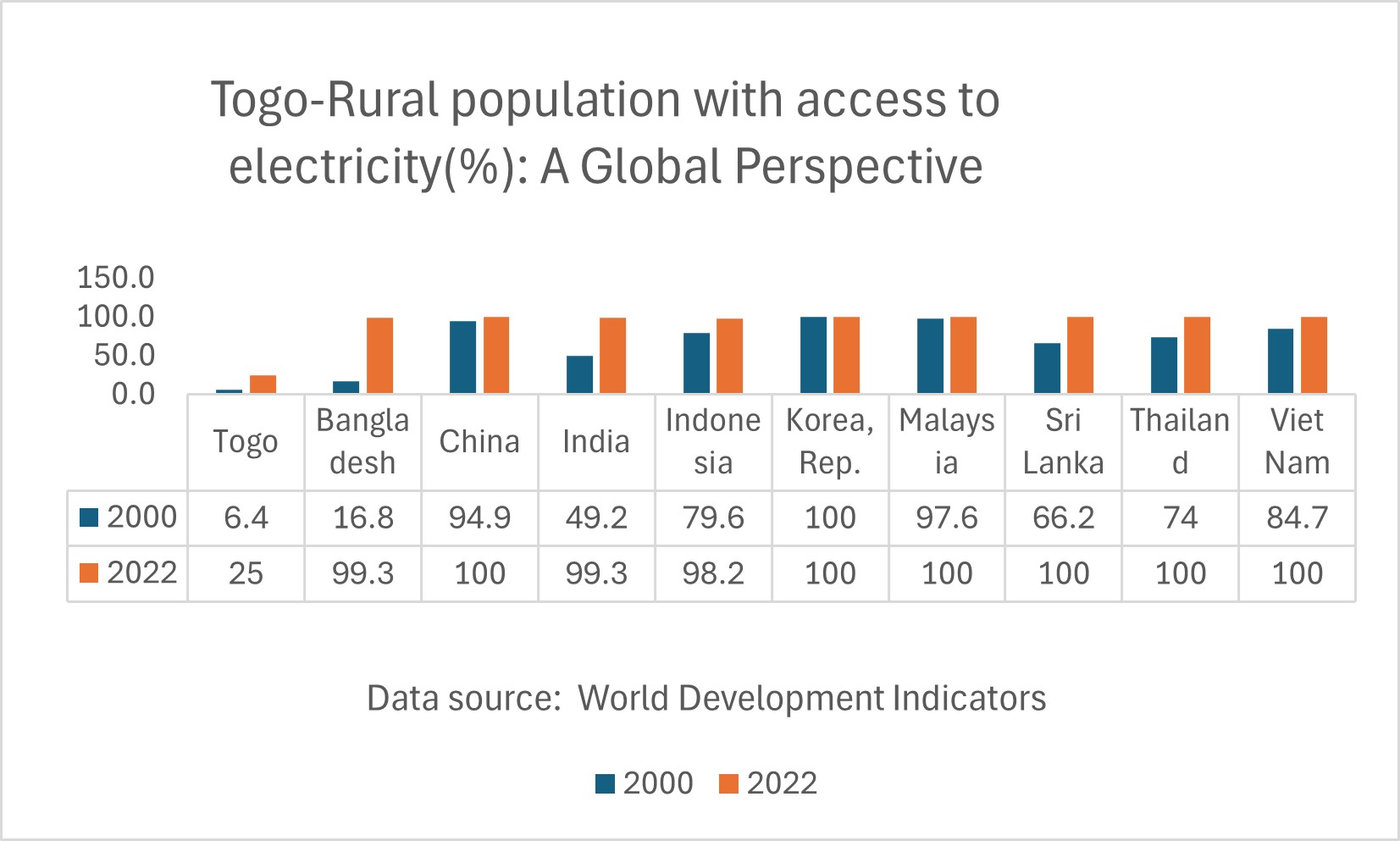
Togo- Health outcomes
Togo-Life expectancy: A Global Perspective
When examining life expectancy trends over the past seven decades, it is evident that significant global advancements have occurred, reflecting improvements in healthcare, technology, and living standards. The average life expectancy at birth worldwide has risen from 47 years in 1950 to an impressive 71 years by 2021. However, progress in most Sub-Saharan African nations has been minimal and concerningly stagnant. For instance, Togo’s life expectancy improved from just 43 years in 1960 to only 62 years in 2022, a modest increase that underscores ongoing challenges. In stark contrast, South Korea experienced a remarkable surge, with life expectancy soaring from 54 years in 1960 to an extraordinary 83 years in 2022, illustrating the potential for transformation in health outcomes. Similarly, the Maldives witnessed substantial growth, with life expectancy climbing from 39 years to 81 years during this same period. These stark disparities highlight the pressing challenges posed by inadequate governance and insufficient healthcare systems in many Sub-Saharan African countries, emphasizing the need for targeted interventions to enhance life expectancy in these regions and bridge the widening gap on a global scale.

Togo- Mortality rate, under-5 (per 1000 live births): A Global Perspective
Since 1950, child mortality rates worldwide have experienced significant declines, a trend that can be attributed largely to improvements in living standards, advancements in healthcare, enhanced nutrition, and increased access to safe drinking water. In affluent nations throughout Europe and America, the child mortality rate has dropped to below 4 percent, reflecting the effectiveness of well-established healthcare systems and sound governance. Over the past seven decades, numerous developing countries in South America, Asia, and Africa have made remarkable strides in reducing child mortality; nevertheless, progress in several Sub-Saharan African nations has been notably sluggish. For instance, Togo has seen a decrease in child mortality rates from a staggering 179 per 1,000 live births in 1980 to 60 in 2022, a gradual improvement that underscores ongoing challenges. In stark contrast, Bangladesh has achieved an extraordinary reduction from 206 in 1980 to just 29 in 2022, while India has similarly lowered its rate from 169 to 29 during the same time frame, highlighting the disparities in governance, healthcare effectiveness, and the urgent need for targeted strategic interventions in Sub-Saharan Africa to ensure equitable progress for all children.

Togo- Maternal mortality ratio (per 100,000 live births): A Global Perspective
The chart below highlights the alarming annual incidence of pregnancy-related deaths, drawing attention to the severe disparities that exist across different regions and countries. It is clear that the vast majority of these devastating losses occur in Sub-Saharan Africa, a region characterized by a high birth rate yet significantly burdened by disproportionately elevated maternal mortality rates. For instance, while Togo has experienced only a modest reduction in maternal deaths, decreasing from 479 in 2000 to 399 in 2020, this progress is overshadowed by the remarkable advancements seen in Bangladesh, where maternal deaths decreased from 441 in 2000 to a remarkable 123 in 2020. Similarly, India has also made commendable strides, lowering its maternal mortality rate from 384 in 2000 to an impressive 103 in 2020. However, the data starkly illuminates that Sub-Saharan Africa continues to grapple with the highest maternal mortality ratios among developing regions, underscoring the urgent need for collective action and targeted interventions that are crucial for fundamentally improving maternal health and well-being across Sub-Saharan Africa.
